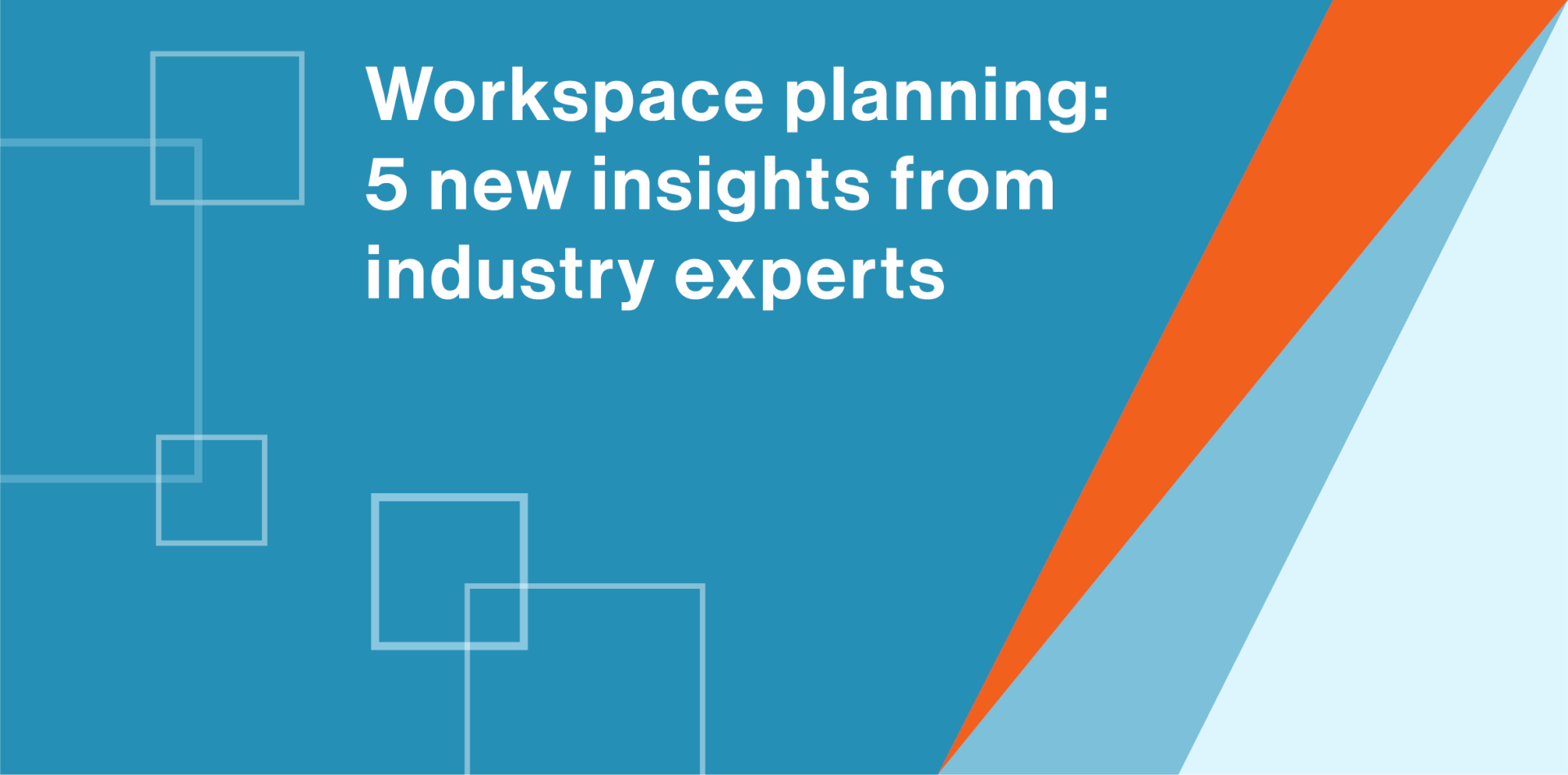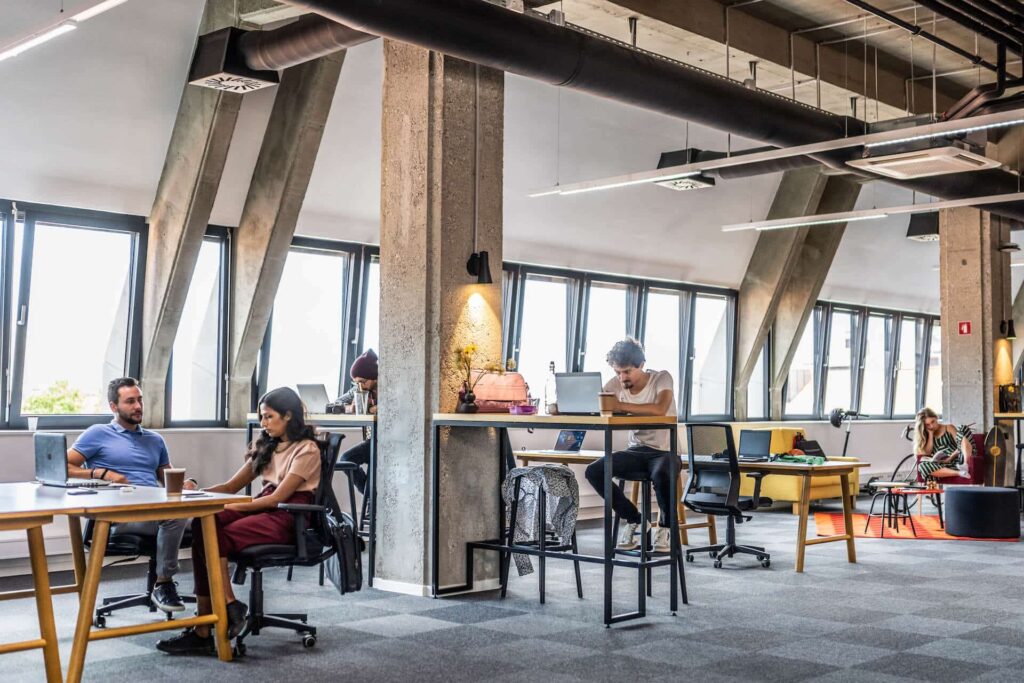Workplace Planning Revolutionized: 5 Fresh Insights from Industry Leaders

Workspace planning is becoming increasingly important and increasingly challenging as work becomes more flexible and hybrid.
There’s no doubt that hybrid offices can be more difficult to understand and optimize than their traditional counterparts.
But when planners use the right metrics and resources, the transition to hybrid can be an opportunity to test new ideas and dramatically improve the workplace for all stakeholders.
In this article, we explore tangible ways you can improve your workspace planning process to overcome the biggest challenges of hybrid working.
We’re drawing on insights from our recent webinar in partnership with CBRE, Cutting Through The Hybrid Workplace Noise.
In this webinar, industry experts Susan Wasmund, Senior Managing Director of Occupancy Management at CBRE, and Maya Ketter, OfficeSpace VP of Client Success, both explore common misconceptions about planning offices for hybrid work.
And, of course, they also share their new best practices for future-proof workspace planning.
Improve your hybrid workspace: 5 office planning best practices
Amid all the rapid change in today’s work environment, one constant has emerged… The need for workplaces to stay nimble, so that companies can test and experiment with new models and configurations.
“Hybrid is a dynamic strategy that is forever changing and might be forever changing,” says Ketter. “You need to experiment and make sure you learn and iterate towards the goal you’re reaching for. 2023 is really about a growth mindset.”
Old ways of understanding workplace planning—ways that may have worked for decades—simply don’t work anymore. Old benchmarks and assumptions about strategic space management aren’t as useful, while many traditional metrics—like vacancy and occupancy rates, density, and square foot per seat—simply can’t capture the real life, real time use of office space.
This can leave facility managers (FMs) and space planners scrambling to make more modern office floor plans. But without modern data methods and technologies to do so.
To keep up, more and more companies are turning to workspace planning software. This helps them manage the nuances of dynamic office use.
And, as Wasmund and Ketter explain, anyone involved in office design and planning for today’s hybrid workplace will need to be aware of (and hopefully follow) the following new best practices for workspace planning.
Use new demand planning strategies
The challenge:
Occupancy planners of yore tended to rely on headcount to plan their spaces and office layouts.
Now that companies are embracing shared and flexible seating, planners need to adapt their demand planning process. One seat to one person is easy math. One seat to multiple people, all of whom come into the office on their own hybrid schedules, is much more challenging.
The fix:
Adapt your demand planning process using macro and micro utilization data to plan sharing rations that ensure employees have what they need when they come into the office.
“We are looking at the growth, but we are applying ratios and sharing efficiencies, which is a much different concept,” says Wasmund.
Embrace actionable metrics
The challenge:
Measuring your space based on density metrics (like vacancy and occupancy rates) is too limited to understand the nuances of hybrid workplace use.
The fix:
Adopt more actionable metrics, joining the 90% (and growing) of CBRE clients using utilization data.
“There’s a huge shift away from using more static data points and metrics, to measuring reality,” says Wasmund.
Create new and better benchmarks
The challenge:
No straight-forward or single ‘rule book’ has emerged for workspace planning for hybrid. Each company, department, and team will have different requirements. So what works for one company, department, or team won’t work for another.
The fix:
Design new benchmarks specifically for your organization, based on measuring the goals you’re trying to accomplish. This should be an iterative process. Don’t worry if it takes trial and error to determine what new workspaces will work best.
“Think about this intentionally for your business needs,” says Maya. “What we have seen most successful organizations do is set a baseline that works for them internally.”
Data-driven strategies for cost-effective workspaces
The challenge:
Leadership in particular may mistakenly believe that hybrid work requires capital improvement or renovations. This misconception can easily stymie growth and workplace design.
The solution:
When you’re collecting the right data and focusing on internal benchmarks, it’s much easier to make cost-conscious decisions, focusing your spending on data-driven, high-impact solutions.
“As much as you can, take the space you have today and create those additional spaces that people need,” says Wasmund. “With minimal investment, companies create more collaboration spaces in the spaces they [already] have, and potentially transform one-to-one stations or offices into huddle rooms, conference rooms, or mobile offices that anyone can use.”
Leverage existing data, tools, and technology
The challenge:
Decision-makers may also mistakenly believe that hybrid work requires complicated technology, or technology that’s quickly outdated. In a world of shrinking budgets and economic uncertainty, investing in new tech can be a big ask.
The reality:
Whether they realize it or not, many organizations have solutions in place to implement and start testing a hybrid workplace strategy.
The same room and desk booking tools you use in OfficeSpace can also provide detailed workplace reports and analytics. This can help companies see when and where people are coming into the office.
Easily layer in data from HR, your badge system, and WiFi, and suddenly you have the ability to build a really complete picture of office use. Down to the department, team, and even desk level.
Investments in more costly IoT sensors may be the right choice for some enterprises. Which is why OfficeSpace integrates with leading sensor providers like SenzoLive and Verge Sense.
But maximizing your space management software is a simple, direct, and cost-effective solution to get the data needed for workspace planning, while also creating a frictionless employee experience.

Why is workplace planning important?
Workspace planning touches virtually every department and individual in an organization, supporting both employee needs and business needs. Improving the functionality of the office is ultimately about improving the functionality of the company.
That means that while workspace planning is usually spearheaded by FM and/or space planning teams, it will have ripple effects throughout the enterprise, impacting virtually every team member and stakeholder in the office. HR teams need access to utilization data to measure employee experience, for example. And the IT teams need to understand where and how to introduce or improve hybrid workplace technology.
Utilization data helps everyone
“Utilization data is not just for occupancy planning, but it’s really for the entire enterprise to understand how to better use their space,” says Wasmund.
On a broad level, bringing this utilization data into workspace planning for hybrid offices can allow for more informed and strategic real estate decision-making.
And it can help ensure that in-office employee experience and engagement remains high.
Beyond this, specific benefits from workspace design and planning will vary, depending on the organization. There’s no ‘one size fits all’ when it comes to workplace planning for a hybrid workplace. Different organizations will have different goals for their spaces, and can therefore expect different results.
“We’re in an era of experimenting and transformation,” says Ketter. “We have to set our own bench lines. What we have seen most successful organizations do is set a baseline that works for them internally.”
That said, some of the common offshoots from better space optimization include increased employee productivity, improved workflows, a more collaborative culture in the workplace, workplace wellbeing, and even employee empowerment.
Making workplace planning an ongoing process
“Having a change management program is key,” insists Wasmund.
Moreover, the future of work is one where the office (and how people use it) will always be changing. And that’s ok!
Workspace management and planning should always be a work in progress. That’s whether you’re designing a completely new office, reworking existing floor plans, or focusing on improving specific key areas of the office.
Ultimately, workplace agility is the best hybrid workplace change strategy. Assuming you collect and understand the right metrics and set new benchmarks, you’ll be able to see what’s happening ‘in real life’ and make adjustments as needed.
Doing so will allow you to create what Ketter calls ‘intentional hybrid,’ where you can start to create some predictability, despite all the noise. “You’ll know that you’re doing the right thing if it helps drive your organization forward,” she says.
Workplace Planning FAQs
What is the meaning of workspace management?
Workspace management is the process of organizing, optimizing, and maintaining physical and digital workspaces. The goal of this process is typically to improve productivity, efficiency, business performance, and/or employee engagement and experience. All while still controlling for real estate. Workspace management is most often handled by facility managers (FMs) and/or space/occupancy planners, sometimes in collaboration with IT and other departments. Note that while workspace management has always been a key role, it is becoming increasingly important and challenging in a hybrid workplace environment. It can therefore require new tools, software, and approaches, and/or more company-wide/cross-departmental involvement than in the past.
How do I create a perfect workspace?
There is no one perfect workspace. Each office is going to require its one unique mix of conference rooms and collaborative workspaces, private offices, open spaces, cubicles, and other types of workstations and cubicles. Some companies may also include coworking space in the mix. FMs and space planners will therefore need to develop a change management system that allows them to plan, design, and then continually redesign spaces around employee needs, internal goals, budgets, and the types of activities that need to happen in the office.
What are some of the factors that affect how people work in a workspace?
Two major factors impact how people work in a workspace. First is whether they have the right types of workstations, private spaces, and meeting rooms for the work they need to do. To ensure employees have what they need, companies often use flexible working software that lets them ask and answer better questions about real-time office use. Second is whether their colleagues are also in-office, and how easily they can collaborate with them. For this reason, many companies use working neighborhoods and flexible seating arrangements that allow employees to sit with the right people at the right time. A visual directory is also incredibly useful, especially when employees are trying to align their own hybrid schedules. Note that with the current rise in remote work, many companies also have to consider how people work outside the physical office. For this reason, many companies now provide stipends to remote and hybrid workers. This is to ensure they’re able to outfit their home offices so that they’re comfortable and optimized, too.
What does a good workspace look like?
A good workspace is one that meets the needs of the people who are using it. As such, there is no one benchmark for what ‘good’ looks like. Ultimately, a ‘good workspace’ is one that has been custom designed and optimized, using real-time data around its real-time use. That said, workplaces that are well optimized typically will have the right mix of heads-down and collaborative spaces. This is along with reliable wayfinding options (often in the form of wayfinding kiosks), good meeting room design, helpful and on-brand room names, reliable WiFi, an employee badge system, and a variety of space types and workplace collaboration tools to choose from. More important than what workspaces look like, is how easy they are to use. For this reason, intuitive desk and room booking software that is available by mobile app and Slack and Teams integration can dramatically improve how employees are able to interact with the spaces available to them.
Photos: vm




